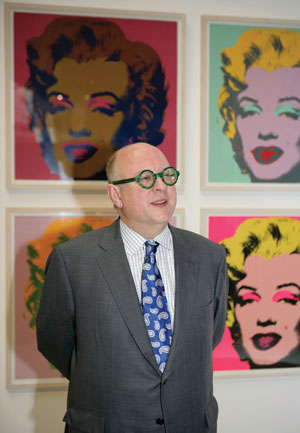 Spring 2008
Spring 2008|
“Home is familiar, cozy, non-judgmental, and easy to navigate. Great qualities for a thatch-covered cottage, but not quite for a bustling metropolis, a nation—or, for that matter, a museum.” Right: Tom Sokolowski at the Leeum, Samsung Museum of Art in Seoul, South Korea. |
Consider some history. Victorian London was the center of the known world in the later 19th century; at one time not that long ago, everyone came to early 20th-century Pittsburgh to buy our steel; and whether your catch was a prized Black Tulip bulb, spices from the Levant, or a rare Turkish carpet, Amsterdam in the mid-17th century was a shopping mecca like none other on the planet. Well…the sun has set on the British Empire, the Pittsburgh steel-based economy tanked in the ’80s, and one of the greatest dangers facing the Dutch environment today is the noxious excess of bovine flatulence (I kid you not!!!!!). Things change. With this in mind, Carnegie Museums of Pittsburgh has set itself the task of moving round the world, actually or virtually, to share its treasures and great ideas with fellow citizens of the planet. Heaven forbid that we should wiggle and waggle, worrying only about the denizens of Panther Hollow when there is a larger world to conquer. And heaven forbid that the products we send abroad—including ourselves!—be wrapped in anything but an osmotic membrane, and not one that repels honest questioning, parallel strategies, or, even, heavy disagreement. All of these are necessary aspects of a 21st-century learning curve. Scientists have it right. As a non-scientist, I have been constantly amazed over the years at the multiple multinational teams of scientific Nobel Prize winners that have worked intensely on projects over the years while residing halfway around the globe from one another. Our own scientists at the Museum of Natural History are examples of this (see The Explorers Club). No one will give a damn who lived at 556 Amberson Place 10 years from now, but the world still cares about Dr. Jonas Salk’s serum. If you are a Pittsburgher, you should be proud that Andrew Carnegie and Andy Warhol have produced a world of culture and creativity that is known by all and is constantly being re-molded, re-crafted, and admired, at home and all over this planet (The Art of Being Human). The Carnegie Museums of today follows in their giant footsteps. So don’t be surprised if you see bits of us along the Champs Elysees, or in Roppongi Hills, or even in downtown Delhi (see Traveling Warhol). You might even see us on TV or hear our voices on morning talk shows, speaking with a resounding authority about who knows what (minus the self-promotion of a Cyril Wecht or Dr. Phil)!? We are everywhere. 
Thomas Sokolowski |
Traveling Warhol · The Art of Being Human · The Explorers Club · Seeing Stars · The Future is Now · NewsWorthy · Now Showing · Face Time: Matt Wrbican · Science & Nature: A Scoop Full · Artistic License: Animal Attraction · First Person: Full Body Experience · Then & Now: The museum as classroom
 |
Copyright © 2017 CARNEGIE Magazine. All rights reserved. |

 Just as Dorothy once said, “There’s no place like Home!” Home is familiar, cozy, non-judgmental, and easy to navigate. Great qualities for a thatch-covered cottage, but not quite for a bustling metropolis, a nation—or, for that matter, a museum.
Just as Dorothy once said, “There’s no place like Home!” Home is familiar, cozy, non-judgmental, and easy to navigate. Great qualities for a thatch-covered cottage, but not quite for a bustling metropolis, a nation—or, for that matter, a museum.